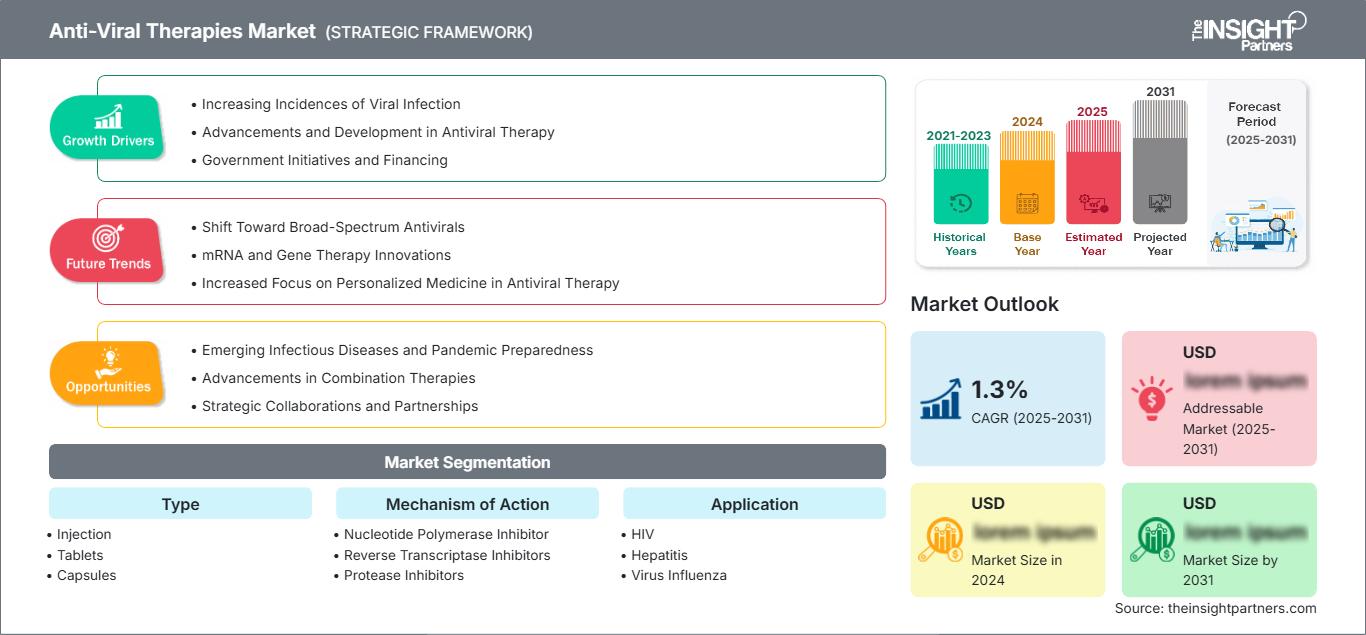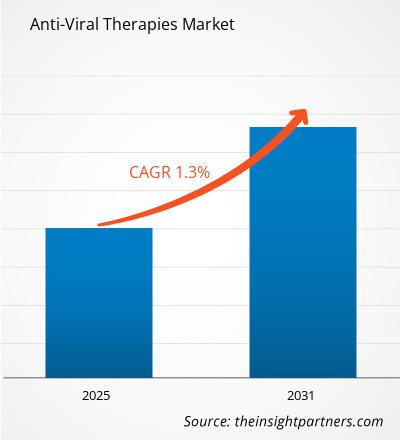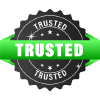The Anti-Viral Therapies Market is expected to register a CAGR of 1.3% from 2025 to 2031, with a market size expanding from US$ XX Million in 2024 to US$ XX Million by 2031.
Anti-Viral Therapies Market report is segmented into Type, Mechanism of Action, and Application. Type analysed include generic drugs and branded drugs. Mechanism of action include Nucleotide polymer inhibitor and reverse transcriptase inhibitors, Protease Inhibitors, and Others. This report analyse Applications such as HIV, Hepatitis, Virus Influenza, Herps, and Other. The regional analysis covers key markets such as North America, Europe, Asia Pacific, the Middle East and Africa, and South America. The market evaluation is presented in US$ for all segmental analyses.
Purpose of the Report
The report Anti-Viral Therapies Market by The Insight Partners aims to describe the present landscape and future growth, top driving factors, challenges, and opportunities. This will provide insights to various business stakeholders, such as:
- Technology Providers/Manufacturers: To understand the evolving market dynamics and know the potential growth opportunities, enabling them to make informed strategic decisions.
- Investors: To conduct a comprehensive trend analysis regarding the market growth rate, market financial projections, and opportunities that exist across the value chain.
- Regulatory bodies: To regulate policies and police activities in the market with the aim of minimizing abuse, preserving investor trust and confidence, and upholding the integrity and stability of the market.
Anti-Viral Therapies Market Segmentation
Type
- Injection
- Tablets
- Capsules
Mechanism of Action
- Nucleotide Polymerase Inhibitor
- Reverse Transcriptase Inhibitors
- Protease Inhibitors
Application
- HIV
- Hepatitis
- Virus Influenza
- Herpes
- Other Applications
You will get customization on any report - free of charge - including parts of this report, or country-level analysis, Excel Data pack, as well as avail great offers and discounts for start-ups & universities
Anti-Viral Therapies Market: Strategic Insights

-
Get Top Key Market Trends of this report.This FREE sample will include data analysis, ranging from market trends to estimates and forecasts.
Anti-Viral Therapies Market Growth Drivers
- Increasing Incidences of Viral Infection: Emerging concerns with respect to the increasing burden of viral infections such as influenza, hepatitis, HIV, and emerging viral diseases, including COVID-19 and RSV, is one of the foremost propellers in the growth of the antiviral therapies market. Since these infections remain a global health dilemma, the drive for efficacious treatment modalities continues. Chronic viral infections by hepatitis B and C alone are a scourge for millions of people across the globe, consequently requiring long-term management, creating a sustainable demand for antiviral medication. The re-surfacing of several viral threats and the seasonal epidemics of influenza fast-track the need for new and improved antiviral therapies. It is the continuing mutations of the virus that lead to drug resistance and is a growing concern, re-emphasizing R&D on next-generation antiviral drugs by also diversifying or creating a new mechanism of action. Governments and health organizations have reiterated the importance of antiviral therapies within their public health programs, having a greater role to play in the growth of the market. The rising incidence of viral infections amongst immunocompromised persons-including those being treated for cancer or receiving organ transplants-is also further fuelling the demand for efficacious antiviral treatment.
- Advancements and Development in Antiviral Therapy:
The Antivirals Developing sector started innovating, changing the market scenario itself. There were tremendous advancements, among many others, in efficacy, safety, and route of administration. Human immunodeficiency virus (HIV) and direct-acting antiviral treatments are revolutionizing hepatitis C treatment with high cure rates and low incidence of adverse reactions. Long-acting injectable drugs are reducing adherence hassles by increasing intervals of dosing for HIV treatment. In addition, encouraging research into host-targeted antivirals is gathered steam. The focus of these antiviral drugs essentially targets host cell components or factors instead of the virus itself. As far as the next-generation artificial antiviral agents like protease inhibitors and polymerase inhibitors are concerned, there are positive advances in the development of options in therapeutic treatments for several viral infections. Advances in nanotechnology and lipid-based drug delivery systems allow for better bioavailability and targeted drug delivery, thereby minimizing systemic side effects. Collectively, these innovational endeavors fuel the advancement of the antiviral therapeutics market by bestowing patients with more efficacious and patient-comfortable treatment options.
- Government Initiatives and Financing:
Yet, the governments and international health organizations together hold the key towards making an effort in this market for antiviral therapies through funding, adopting supportive policies, and conducting research. In light of viral outbreaks and global threats, there has been increased funding for research into developing antiviral drugs by governments across the world in an effort to enhance pandemic preparedness. Programs such as the U.S. Biomedical Advanced Research and Development Authority (BARDA) and the European Medicines Agency (EMA) actively offer funding and regulatory incentives to encourage the development of new antiviral agents. The World Health Organization (WHO) also partners with various pharmaceutical companies and research institutions to develop novel antiviral therapies for neglected and emerging infectious diseases. Also, initiatives like the Global Fund to fight AIDS, Tuberculosis, and Malaria support access to antiviral medicines across the developing world. Of late, public-private partnerships have obtained heightened momentum with government and Pfizer foundations collaborating with academic institutions.
Anti-Viral Therapies Market Future Trends
- Shift Toward Broad-Spectrum Antivirals: The development of broad-spectrum antivirals is gaining momentum as pharmaceutical companies and researchers seek treatments that can target multiple viruses simultaneously. Traditional antiviral drugs are often designed for specific viral strains, limiting their applicability. However, with the increasing frequency of viral mutations and emerging infectious diseases, there is a pressing need for broad-spectrum antivirals that can provide a wider range of protection. These drugs work by targeting conserved viral elements or host factors essential for viral replication, making them effective against multiple pathogens. The COVID-19 pandemic accelerated interest in such treatments, leading to the development of drugs like remdesivir, which demonstrated efficacy against multiple coronaviruses. Broad-spectrum antivirals offer a strategic advantage in pandemic preparedness, as they can be deployed quickly to combat new viral threats. The pharmaceutical industry is investing heavily in this area, with multiple research initiatives focusing on repurposing existing drugs and developing novel antiviral agents with broad applicability.
- mRNA and Gene Therapy Innovations: The success of mRNA vaccines for COVID-19 has paved the way for mRNA-based antiviral therapies, which hold immense potential for treating viral infections. Unlike traditional antiviral drugs that target viral proteins, mRNA therapeutics can be designed to enhance the body’s immune response or directly interfere with viral replication. Pharmaceutical companies are exploring the use of mRNA technology for diseases such as HIV, hepatitis B, and herpes viruses. Additionally, gene-editing technologies like CRISPR are being studied as potential tools for eradicating persistent viral infections, offering a long-term cure rather than symptomatic management. Advances in lipid nanoparticle (LNP) delivery systems are also improving the stability and effectiveness of mRNA-based antivirals. The rapid development timeline of mRNA therapies, coupled with their adaptability to emerging viral threats, positions them as a transformative trend in the antiviral market. Several biotech companies and research institutions are currently conducting clinical trials to evaluate the efficacy of these next-generation antiviral treatments.
- Increased Focus on Personalized Medicine in Antiviral Therapy:
Personalized medicine is becoming a major trend in the antiviral therapies market, driven by advancements in genomics, biomarker research, and precision medicine approaches. Unlike traditional “one-size-fits-all” antiviral treatments, personalized medicine aims to tailor therapies based on individual genetic makeup, immune response, and viral strain variations. This approach is particularly significant in managing chronic viral infections such as HIV, hepatitis, and herpes, where patient response to antiviral drugs can vary significantly. Pharmacogenomic testing is now being integrated into clinical practice to optimize drug selection and dosage, reducing adverse effects and enhancing treatment efficacy. For example, certain antiviral drugs used in HIV treatment are more effective in patients with specific genetic markers, allowing for customized regimens. Additionally, personalized medicine is enabling better monitoring of antiviral resistance, ensuring that patients receive therapies that remain effective over time. With the growing use of artificial intelligence (AI) and big data in healthcare, personalized antiviral treatment strategies are expected to become more precise, leading to better patient outcomes and more efficient resource utilization.
Anti-Viral Therapies Market Opportunities
- Emerging Infectious Diseases and Pandemic Preparedness:
The ongoing threat of emerging and re-emerging infectious diseases creates numerous opportunities for the antiviral therapeutics market. Outbreaks of novel viruses such as SARS-CoV-2, avian influenza, and Nipah virus highlight the urgent need for rapid-response antiviral therapies. Governments and pharma companies have opened their purses wide to invest in pandemic preparedness and fund research programs that aim to create broad-spectrum antivirals and next-gen therapeutic solutions. The WHO and other health agencies have flagged a few priority pathogens for immediate research efforts: this opens avenues for market expansion. Also, regulatory agencies are accelerating the approval of antiviral drugs through expedited designations for promising candidates. Companies that invest in antiviral platforms that can rapidly adapt to new viral threats will gain a foothold in this competitive environment. Additionally, establishment of the global antiviral stockpiles along with investments in antiviral R&D may provide a further fillip to market growth. - Advancements in Combination Therapies: The increasing adoption of combination therapies in antiviral treatment offers significant opportunities for improved clinical outcomes. Combination therapies, which involve using two or more antiviral agents with complementary mechanisms of action, have proven highly effective in conditions such as HIV, hepatitis C, and influenza. These regimens help prevent viral resistance, enhance drug efficacy, and reduce treatment duration. For example, HIV treatment has evolved from single-drug regimens to highly effective combination therapies that suppress viral replication with minimal side effects. Similarly, in hepatitis C treatment, direct-acting antiviral (DAA) combinations have achieved cure rates exceeding 95%. The growing understanding of viral pathogenesis is driving the development of new combination approaches, including the use of immunomodulators alongside antivirals. Pharmaceutical companies investing in novel combination therapies that enhance efficacy while minimizing resistance stand to capture a larger market share, particularly in the chronic viral disease segment.
- Strategic Collaborations and Partnerships: The antiviral therapies market is witnessing a surge in strategic collaborations between pharmaceutical companies, biotechnology firms, and academic institutions. These partnerships are crucial for accelerating drug discovery, improving R&D efficiency, and expanding access to new antiviral treatments. Large pharmaceutical companies are increasingly engaging in licensing agreements and joint ventures with biotech startups that specialize in cutting-edge antiviral technologies, such as RNA-based therapeutics and AI-driven drug discovery. Additionally, governments and non-profit organizations are funding collaborative research initiatives to develop affordable and widely accessible antiviral drugs. An example of such collaboration is the partnership between the Bill & Melinda Gates Foundation and various pharmaceutical companies to accelerate the development of antiviral treatments for global infectious diseases. Mergers and acquisitions in the antiviral space are also increasing, allowing companies to diversify their portfolios and strengthen their market position. By leveraging collective expertise and resources, these collaborations drive innovation and expand the reach of antiviral therapies across different patient populations.
Anti-Viral Therapies Market Regional Insights
The regional trends and factors influencing the Anti-Viral Therapies Market throughout the forecast period have been thoroughly explained by the analysts at The Insight Partners. This section also discusses Anti-Viral Therapies Market segments and geography across North America, Europe, Asia Pacific, Middle East and Africa, and South and Central America.
Anti-Viral Therapies Market Report Scope
| Report Attribute | Details |
|---|---|
| Market size in 2024 | US$ XX Million |
| Market Size by 2031 | US$ XX Million |
| Global CAGR (2025 - 2031) | 1.3% |
| Historical Data | 2021-2023 |
| Forecast period | 2025-2031 |
| Segments Covered |
By Type
|
| Regions and Countries Covered |
North America
|
| Market leaders and key company profiles |
|
Anti-Viral Therapies Market Players Density: Understanding Its Impact on Business Dynamics
The Anti-Viral Therapies Market is growing rapidly, driven by increasing end-user demand due to factors such as evolving consumer preferences, technological advancements, and greater awareness of the product's benefits. As demand rises, businesses are expanding their offerings, innovating to meet consumer needs, and capitalizing on emerging trends, which further fuels market growth.

- Get the Anti-Viral Therapies Market top key players overview
Key Selling Points
- Comprehensive Coverage: The report comprehensively covers the analysis of products, services, types, and end users of the Anti-Viral Therapies Market, providing a holistic landscape.
- Expert Analysis: The report is compiled based on the in-depth understanding of industry experts and analysts.
- Up-to-date Information: The report assures business relevance due to its coverage of recent information and data trends.
- Customization Options: This report can be customized to cater to specific client requirements and suit the business strategies aptly.
The research report on the Anti-Viral Therapies Market can, therefore, help spearhead the trail of decoding and understanding the industry scenario and growth prospects. Although there can be a few valid concerns, the overall benefits of this report tend to outweigh the disadvantages.
Frequently Asked Questions
Which are the key players in the Anti-Viral Therapies Market?
What are the deliverable formats of the Anti-Viral Therapies Market?
What is the expected CAGR of the Anti-Viral Therapies Market?
What are the driving factors impacting the Anti-Viral Therapies Market?
What are the future trends in the Anti-Viral Therapies Market?
What are the options available for the customization of this report?
- Historical Analysis (2 Years), Base Year, Forecast (7 Years) with CAGR
- PEST and SWOT Analysis
- Market Size Value / Volume - Global, Regional, Country
- Industry and Competitive Landscape
- Excel Dataset
Recent Reports
Testimonials
Reason to Buy
- Informed Decision-Making
- Understanding Market Dynamics
- Competitive Analysis
- Identifying Emerging Markets
- Customer Insights
- Market Forecasts
- Risk Mitigation
- Boosting Operational Efficiency
- Strategic Planning
- Investment Justification
- Tracking Industry Innovations
- Aligning with Regulatory Trends





















 Get Free Sample For
Get Free Sample For